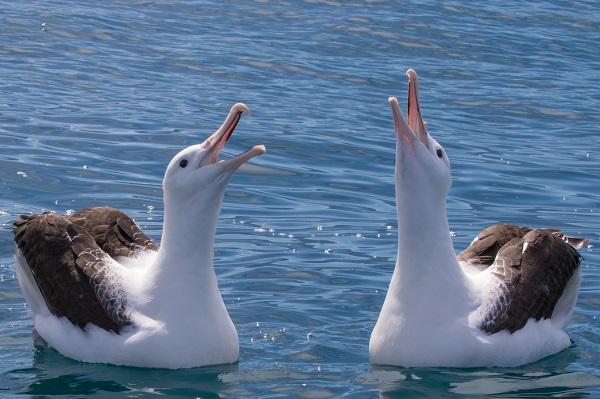 Monitoring the population of Northern Royal Albatrosses (pictured) was one area of focus for the research on New Zealand's Chatham Islands. Photograph by David Brooks
Monitoring the population of Northern Royal Albatrosses (pictured) was one area of focus for the research on New Zealand's Chatham Islands. Photograph by David Brooks
A collection of reports on albatross research conducted on the Chatham Islands has been published by New Zealand’s Department of Conservation.
The Publications:
Motuhara seabird research field trip December 2022 (PDF, 182K)
A summary of each report follows:
“The field work has been undertaken on Motuhara Island, a privately owned island east of Chatham Island with some of the most significant albatross colonies in New Zealand. Mike Bell (Toroa Consulting Ltd) visited the colony in December 2022 to collect tracking tags of northern Buller’s albatross/mollymawk (Thalassarche bulleri platei), download trail camera footage from cameras left out over the previous 12 months, carry out banding of birds for demographic studies and conduct counts of albatrosses and northern giant petrels (Macronectes halli).
The trail camera footage from 2021 for northern royal albatross (Diomedea sanfordi) and northern Buller’s albatross was analysed by Peter Frost (Science Support Services). This was looking at breeding success at monitored nests, timing and causes of nest failures, activity levels across the daily cycle to inform aerial survey techniques and other observations relevant to the behaviour of the birds across the nesting cycle. Dates of departure of chicks are provided. Climate related issues on the colony are assessed in the report.
Global location sensing tags (GLS) were applied to northern Buller’s albatross as well as southern Buller’s albatross (Thalassarche bulleri) on the Snares Island (Tini Heke). Johannes Fischer has analysed the tracking datasets (n=69 from northerns and n=28 from southerns) to show patterns of annual movements, migration routes and core foraging zones both within the New Zealand EEZ and the high seas and when the birds reach South American waters off Chile and Peru. There are temporal differences in the timing of breeding with a four month difference in peak breeding: northerns departing earlier and returning earlier than southerns, reducing spatial and temporal overlap in their foraging ranges here and off South America. Northerns largely remain north and east of the Chatham Rise whereas southerns are common off southern and western South Island, and off Otago and Canterbury. Some birds reach the seas off Australia.
The satellite tracking of northern royal albatross in 2021 is reported by Samhita Bose. This species had tags applied on Motuhara and the birds stayed exclusively within the New Zealand EEZ during chick rearing. After breeding failure or at the end of the season the birds migrated to the seas off western and eastern South America (Chile, Patagonia and Argentina). Issues with the loss of aerials on tags on some tags were identified with this project. Also a pair of northern royals and their chick from Taiaroa Head were tracked in 2021 and the results presented in this report. The male from this pair made the only visit to the Tasman Sea of the 33 birds involved in this study.”
Publication information
Bell, M. 2023. Motuhara seabird research: field trip report December 2022. Report prepared by Toroa Consulting Limited for the Conservation Services Programme, Department of Conservation. 4 p.
Frost, P., Bell, M., Taylor, G. 2023. Trail-camera assessment of the fates of Northern Royal Albatross and Northern Buller’s Mollymawk chicks: 2021 breeding season, Motuhara. Report prepared for the Conservation Services Programme, Department of Conservation. 25 p.
Bose, S., Bell, M., Taylor, G. 2023. Northern Royal Albatross tracking from Motuhara, Chatham Islands, and Taiaroa Head in 2021. POP2022-06 final report prepared for the Conservation Services Programme, Department of Conservation. 9 p.
Fischer, J.H., Bell, M., Frost, P., Sagar, P.M., Thompson, D.R, Middlemiss, K.L., Debski, I., Taylor, G. 2023. Year-round GLS tracking of Northern Buller’s albatross and comparison with Southern Buller’s albatross. POP2022-05 final report prepared for the Conservation Services Programme, Department of Conservation. 16 p.
23 August 2023

 Français
Français  English
English  Español
Español